Heterostructure Cu2O/(001)TiO2 Effected on Photocatalytic Degradation of Ammonia of Livestock Houses
Abstract
:1. Introduction
2. Results and Discussion
2.1. Morphology Analysis of Carrier (Polyester Fiber)
2.2. X-ray Diffraction of Catalysts
2.3. Crystal Facet Analysis of Catalysts
2.4. Raman Analysis of Catalysts
2.5. Catalyst Morphology Analysis
2.6. Optical Characterization and Band Gap Energy
2.7. XPS Analysis of Catalyst
2.8. Fluorescent Analysis of Catalysts
2.9. Compound Mechanism of Cu2O/(001)TiO2
2.10. Degradation of Ammonia by the Catalysts
2.10.1. Controlled Test of Catalyst Carrier (Polyester Fiber Carrier)
2.10.2. Degradation of Ammonia by Different Catalysts
2.10.3. Degradation of Ammonia by Air Flow Rate
2.10.4. Catalyst Reutilization Performance
3. Materials and Methods
3.1. Materials
3.2. Preparation of (001)TiO2 Catalyst
3.3. Preparation of Cu2O/(001)TiO2 Catalyst
3.4. Catalyst Powder Loading
3.5. Catalyst Characterization
3.6. Experimental Equipment of Photocatalytic Ammonia Gas
3.7. Photocatalytic Test
3.7.1. Controlled Test of Catalyst Carrier (Polyester Fiber)
3.7.2. Degradation of Ammonia by Different Catalysts
3.7.3. Degradation of Ammonia by Air Flow Rate
3.7.4. Catalyst Reutilization Performance
4. Conclusions
Author Contributions
Funding
Acknowledgments
Conflicts of Interest
References
- Wu, Y.; Gu, B.; Erisman, J.W.; Reis, S.; Fang, Y.; Lu, X.; Zhang, X. PM2.5 pollution is substantially affected by ammonia emissions in China. Environ. Pollut. 2016, 218, 86–94. [Google Scholar] [CrossRef] [PubMed]
- Wang, R.; Ye, X.; Liu, Y.; Li, H.; Yang, X.; Chen, J.; Gao, W.; Yin, Z. Characteristics of atmospheric ammonia and its relationship with vehicle emissions in a megacity in China. Atmos. Environ. 2018, 182, 97–104. [Google Scholar] [CrossRef]
- Fuchs, W.; Wang, X.; Gabauer, W.; Li, Z. Tackling ammonia inhibition for efficient biogas production from chicken manure: Status and technical trends in Europe and China. Renew. Sustain. Energy Rev. 2018, 97, 186–199. [Google Scholar] [CrossRef]
- Schauberger, G.; Piringer, M.; Mikovits, C.; Zollitsch, W.; Hörtenhuber, S.J.; Baumgartner, J.; Niebuhr, K.; Anders, I.; Andre, K.; Hennig-Pauka, I. Impact of global warming on the odour and ammonia emissions of livestock buildings used for fattening pigs. Biosyst. Eng. 2018, 175, 106–114. [Google Scholar] [CrossRef]
- Zheng, M.; Zhou, N.; Liu, S.; Dang, C.; Liu, Y.; He, S.; Zhao, Y.; Liu, W.; Wang, X. N2O and NO emission from a biological aerated filter treating coking wastewater: Main source and microbial community. J. Clean. Prod. 2019, 213, 365–374. [Google Scholar] [CrossRef]
- Pu, S.H.; Liu, Z.H.; Yang, F.Y.; Long, D.B.; Liu, W.; Wang, H.; Huang, K.P.; Huang, X. Comparative study on the removal efficiency of hydrogen sulfide (H2S) using three different packings. J. Air Waste Manag. 2018, 68, 900–908. [Google Scholar] [CrossRef] [PubMed]
- Fujishima, A.; Honda, K. Electrochemical Photolysis of Water at a Semiconductor Electrode. Nature 1972, 238, 37–38. [Google Scholar] [CrossRef] [PubMed]
- Popova, G.Y.; Andrushkevich, T.V.; Chesalov, Y.A.; Stoyanov, E.S. In situ FTIR Study of the Adsorption of Formaldehyde, Formic Acid, and Methyl Formiate at the Surface of TiO2 (Anatase). Kinet. Catal. 2000, 41, 805–811. [Google Scholar] [CrossRef]
- Kim, Y.K.; Hong, S.J.; Kim, H.B.; Lee, S.W. Evaluation of In-Situ NOx Removal Efficiency of Photocatalytic Concrete in Expressways. KSCE J. Civ. Eng. 2018, 22, 2274–2280. [Google Scholar] [CrossRef]
- Negishi, N.; Takeuchi, K. Preparation of a transparent thin-film photocatalyst for elimination of VOC. Res. Chem. Intermediat. 2003, 29, 861–879. [Google Scholar] [CrossRef]
- Zhu, Q.; Liu, N.; Zhang, N.; Song, Y.Y.; Stanislaus, M.S.; Zhao, C.Y.; Yang, Y.N. Efficient photocatalytic removal of RhB, MO and MB dyes by optimized Ni/NiO/TiO2 composite thin films under solar light irradiation. J. Environ. Chem. Eng. 2018, 6, 2724–2732. [Google Scholar] [CrossRef]
- Zhang, Y.X.; Xu, M.J.; Li, H.; Ge, H.; Bian, Z.F. The enhanced photoreduction of Cr(VI) to Cr(III) using carbon dots coupled TiO2 mesocrystals. Appl. Catal. B Environ. 2018, 226, 213–219. [Google Scholar] [CrossRef]
- Yang, G.; Chen, D.M.; Ding, H.; Feng, J.J.; Zhang, J.Z.; Zhu, Y.F.; Hamid, S.; Bahnemannd, D.W. Well-designed 3D ZnIn2S4 nanosheets/TiO2 nanobelts as direct Z-scheme photocatalysts for CO2 photoreduction into renewable hydrocarbon fuel with high efficiency. Appl. Catal. B Environ. 2017, 219, 611–618. [Google Scholar] [CrossRef]
- Tambwekar, S.V.; Venugopal, D.; Subrahmanyam, M. H2 production of (CdS–ZnS)–TiO2 supported photocatalytic system. Int. J. Hydrogen Energy 1999, 24, 957–963. [Google Scholar] [CrossRef]
- Endres, P.J.; Tatjana, P.; Stefan, V.; Meade, T.J.; Woloschak, G.E. DNA−TiO2 Nanoconjugates Labeled with Magnetic Resonance Contrast Agents. J. Am. Chem. Soc. 2007, 129, 15760–15761. [Google Scholar] [CrossRef] [PubMed]
- Lettieri, M.; Colangiuli, D.; Masieri, M.; Calia, A. Field performances of nanosized TiO2 coated limestone for a self-cleaning building surface in an urban environment. Build. Environ. 2019, 147, 506–516. [Google Scholar] [CrossRef]
- Zhang, L.; Gao, Q.; Han, Y. Zn and Ag Co-doped Anti-microbial TiO2 Coatings on Ti by Micro-arc Oxidation. J. Mater. Sci. Technol. 2016, 32, 919–924. [Google Scholar] [CrossRef]
- Pan, T.T.; Cao, W.; Wang, M. TiO2 thin film temperature sensor monitored by smartphone. Opt. Fiber Technol. 2018, 45, 359–362. [Google Scholar] [CrossRef]
- Guarino, M.; Costa, A.; Porro, M. Photocatalytic TiO2 coating—To reduce ammonia and greenhouse gases concentration and emission from animal husbandries. Bioresour. Technol. 2008, 99, 2650–2658. [Google Scholar] [CrossRef] [PubMed]
- Costa, A.; Chiarello, G.L.; Selli, E.; Guarino, M. Effects of TiO2 based photocatalytic paint on concentrations and emissions of pollutants and on animal performance in a swine weaning unit. J. Environ. Manag. 2012, 96, 86–90. [Google Scholar] [CrossRef] [PubMed]
- Lee, S.M.; Lee, H.H.; Hong, S.C. Influence of calcination temperature on Ce/TiO2 catalysis of selective catalytic oxidation of NH3 to N2. Appl. Catal. A 2014, 470, 189–198. [Google Scholar] [CrossRef]
- Kolinko, P.A.; Kozlov, D.V. Products distribution during the gas phase photocatalytic oxidation of ammonia over the various titania based photocatalysts. Appl. Catal. B Environ. 2009, 90, 126–131. [Google Scholar] [CrossRef]
- Yamazoe, S.; Okumura, T.; Hitomi, Y.; Shishido, T.; Tanaka, T. Mechanism of Photo-Oxidation of NH3over TiO2: Fourier Transform Infrared Study of the Intermediate Species. J. Phys. Chem. C 2007, 111, 11077–11085. [Google Scholar] [CrossRef]
- Yamazoe, S.; Okumura, T.; Tanaka, T. Photo-oxidation of NH3 over various TiO2. Catal. Today 2007, 120, 220–225. [Google Scholar] [CrossRef]
- Li, H.X.; Bian, Z.F.; Zhu, J.; Huo, Y.N.; Li, H.; Lu, Y.F. Mesoporous Au/TiO2 nanocomposites with enhanced photocatalytic activity. J. Am. Chem. Soc. 2007, 129, 4538–4539. [Google Scholar] [CrossRef] [PubMed]
- Hu, L.Y.; Zhang, Y.M.; Zhang, S.M.; Li, B.X. A transparent TiO2–C@TiO2–graphene free-standing film with enhanced visible light photocatalysis. RSC Adv. 2016, 6, 43098–43103. [Google Scholar] [CrossRef]
- Wu, K.; Cui, J.B. Synthesis of TiO2 nanocrystals with exposed {001} facets and improved photocatalytic activity. Optik 2018, 164, 556–560. [Google Scholar] [CrossRef]
- Lazzeri, M.; Vittadini, A.; Selloni, A. Erratum: Structure and energetics of stoichiometric TiO2 anatase surfaces [Phys. Rev. B 63, 155409 (2001)]. Phys. Rev. B 2002, 65, 1–5. [Google Scholar] [CrossRef]
- Ali, M.M.; Sandhya, K.Y. Selective photodegradation and enhanced photo electrochemical properties of titanium dioxide–graphene composite with exposed (001) facets made by photochemical method. Sol. Energy Mater. Sol. Cells 2016, 144, 748–757. [Google Scholar] [CrossRef]
- Zhou, L.; Wang, L.Z.; Lei, J.Y.; Liu, Y.D.; Zhang, J.L. Fabrication of TiO2/Co-g-C3N4 heterojunction catalyst and its photocatalytic performance. Catal. Commun. 2017, 89, 125–128. [Google Scholar] [CrossRef]
- Hoyer, P.; Konenkamp, R. Photoconduction in porous TiO2 sensitized by PbS quantum dots. Appl. Phys. Lett. 1995, 66, 349–351. [Google Scholar] [CrossRef]
- Yu, S.Q.; Ling, Y.H.; Wang, R.G.; Zhang, J.; Qin, F.; Zhang, Z.J. Constructing superhydrophobic WO3@TiO2 nanoflake surface beyond amorphous alloy against electrochemical corrosion on iron steel. Appl. Surf. Sci. 2018, 436, 527–537. [Google Scholar] [CrossRef]
- Li, Z.Z.; Xin, Y.M.; Zhang, Z.H. New Photocathodic Analysis Platform with Quasi-Core/Shell-Structured TiO2 @Cu2 O for Sensitive Detection of H2O2 Release from Living Cells. Anal. Chem. 2015, 87, 10491–10497. [Google Scholar] [CrossRef] [PubMed]
- Li, G.S.; Wu, L.; Li, F.; Xu, P.P.; Zhang, D.Q.; Li, H.X. Photoelectrocatalytic degradation of organic pollutants via a CdS quantum dots enhanced TiO2 nanotube array electrode under visible light irradiation. Nanoscale 2013, 5, 2118–2125. [Google Scholar] [CrossRef] [PubMed]
- Zoolfakar, A.S.; Rani, R.A.; Morfa, A.J.; Mullane, A.P.; Zadeh, K.K. Nanostructured copper oxide semiconductors: A perspective on materials, synthesis methods and applications. J. Mater. Chem. C 2014, 27, 5247–5270. [Google Scholar] [CrossRef]
- Yang, Q.; Long, M.; Tan, L.; Zhang, Y.; Yang, J.O.; Liu, P.; Tang, A.D. Helical TiO2 Nanotube Arrays Modified by Cu–Cu2O with Ultrahigh Sensitivity for the Nonenzymatic Electro-oxidation of Glucose. ACS Appl. Mater. Interfaces 2015, 7, 12719–12730. [Google Scholar] [CrossRef] [PubMed]
- Senevirathna, M.K.I.; Pitigala, P.K.D.D.P.; Tennakone, K. Water photoreduction with Cu2O quantum dots on TiO2 nano-particles. J. Photochem. Photobiol. A 2005, 171, 257–259. [Google Scholar] [CrossRef]
- Barreca, D.; Carraro, G.; Gasparotto, A.; Maccato, C.; Cruzyusta, M.; Gómezcamer, J.L.; Morales, J.; Sada, C.; Sánchez, L. On the Performances of CuxO-TiO2 (x = 1, 2) Nanomaterials As Innovative Anodes for Thin Film Lithium Batteries. ACS Appl. Mat. Interfaces 2012, 4, 3610–3619. [Google Scholar] [CrossRef] [PubMed]
- Liu, X.M.; Cao, L.M.; Sun, W.; Zhou, Z.H.; Yang, J. A P/N type compounded Cu2O/TiO2 photo-catalytic membrane for organic pollutant degradation. Res. Chem. Intermed. 2016, 42, 6289–6300. [Google Scholar] [CrossRef]
- Syed, N.; Zavabeti, A.; Mohiuddin, M.; Zhang, B.Y.; Wang, Y.C.; Datta, R.S.; Atkin, P.; Carey, B.J.; Tan, C.; Embden, J.; et al. Sonication-Assisted Synthesis of Gallium Oxide Suspensions Featuring Trap State Absorption: Test of Photochemistry. Adv. Funct. Mater. 2017, 27, 1702295. [Google Scholar] [CrossRef]
- Datta, R.S.; Haque, F.; Mohiuddin, M.; Carey, B.J.; Syed, N.; Zavabeti, A.; Zhang, B.; Khan, H.; Berean, K.J.; Ou, J.Z.; et al. Highly active two dimensional α-MoO3−x for the electrocatalytic hydrogen evolution reaction. J. Mater. Chem. A 2017, 46, 24223–24231. [Google Scholar] [CrossRef]
- Wu, H.M.; Ma, J.Z.; Li, Y.B.; Zhang, C.B.; He, H. Photocatalytic oxidation of gaseous ammonia over fluorinated TiO2 with exposed (001) facets. Appl. Catal. B Environ. 2014, 152–153, 82–87. [Google Scholar] [CrossRef]
- Wen, X.; Long, M.; Tang, A. Flake-like Cu2O on TiO2 nanotubes array as an efficient nonenzymatic H2O2 biosensor. J. Electroanal. Chem. 2017, 785, 33–39. [Google Scholar] [CrossRef]
- Lv, K.; Xiang, Q.J.; Yu, J.G. Effect of calcination temperature on morphology and photocatalytic activity of anatase TiO2 nanosheets with exposed {001} facets. Appl. Catal. B Environ. 2011, 104, 275–281. [Google Scholar] [CrossRef]
- D’Amato, C.A.; Giovannetti, R.; Zannotti, M.; Rommozzi, E.; Ferraro, S.; Seghetti, C.; Minicucci, M.; Gunnell, R.; di Cicco, A. Enhancement of visible-light photoactivity by polypropylene coated plasmonic Au/TiO2 for dye degradation in water solution. Appl. Surf. Sci. 2018, 441, 575–587. [Google Scholar] [CrossRef]
- Chu, L.; Qin, Z.F.; Yang, J.P.; Li, X.A. Anatase TiO2 Nanoparticles with Exposed {001} Facets for Efficient Dye-Sensitized Solar Cells. Sci. Rep. 2015, 5, 12143. [Google Scholar] [CrossRef] [PubMed]
- Hou, C.T.; Hu, B.; Zhu, J.M. Photocatalytic Degradation of Methylene Blue over TiO2 Pretreated with Varying Concentrations of NaOH. Catalysts 2018, 8, 575. [Google Scholar] [CrossRef]
- Li, B.X.; Wang, Y.F. Facile synthesis and photocatalytic activity of ZnO–CuO nanocomposite. Superlattices Microstruct. 2010, 47, 615–623. [Google Scholar] [CrossRef]
- Hensel, J.; Wang, G.M.; Li, Y.; Zhang, J.Z. Synergistic Effect of CdSe Quantum Dot Sensitization and Nitrogen Doping of TiO2 Nanostructures for Photoelectrochemical Solar Hydrogen Generation. Nano Lett. 2010, 10, 478–483. [Google Scholar] [CrossRef] [PubMed]
- Park, S.M.; Razzaq, A.; Park, Y.H.; Sorcar, S.; Park, Y.; Grimes, C.A.; In, S.I. Hybrid Cu x O–TiO2 Heterostructured Composites for Photocatalytic CO2 Reduction into Methane Using Solar Irradiation: Sunlight into Fuel. ACS Omega 2016, 1, 868–875. [Google Scholar] [CrossRef]
- Yang, L.; Wang, W.H.; Zhang, H.; Wang, S.H.; Zhang, M.; He, G.; Lv, J.G.; Zhu, K.R.; Sun, Z.Q. Electrodeposited Cu2O on the {101} facets of TiO2 nanosheet arrays and their enhanced photoelectrochemical performance. Sol. Energy Mater. Sol. Cells 2017, 165, 27–35. [Google Scholar] [CrossRef]
- Xu, X.; Gao, Z.H.; Cui, Z.D.; Liang, Y.Q.; Li, Z.Y.; Zhu, S.L.; Yang, X.J.; Ma, J.M. Synthesis of Cu2O Octadecahedron/TiO2 Quantum Dot Heterojunctions with High Visible Light Photocatalytic Activity and High Stability. ACS Appl. Mater. Interfaces 2016, 8, 91–101. [Google Scholar] [CrossRef] [PubMed]
- Li, L.; Lei, J.G.; Jia, T.H. Facile fabrication of p–n heterojunctions for Cu2O submicroparticles deposited on anatase TiO2 nanobelts. Mater. Res. Bull. 2011, 46, 2084–2089. [Google Scholar] [CrossRef]
- Zhang, Z.Y.; Liu, K.C.; Bao, Y.N.; Dong, B. Photo-assisted self-optimizing of charge-carriers transport channel in the recrystallized multi-heterojunction nanofibers for highly efficient photocatalytic H2 generation. Appl. Catal. B 2017, 203, 599–606. [Google Scholar] [CrossRef]
- Yu, J.G.; Yu, H.G.; Cheng, B.; Zhao, X.J.; Yu, J.C.; Ho, W.K. The Effect of Calcination Temperature on the Surface Microstructure and Photocatalytic Activity of TiO2Thin Films Prepared by Liquid Phase Deposition. J. Phys. Chem. B 2003, 107, 13871–13879. [Google Scholar] [CrossRef]
- Ma, Q.L.; Zhang, H.X.; Cui, Y.Q.; Deng, X.Y.; Guo, R.N.; Cheng, X.W.; Xie, M.Z.; Cheng, Q.F. Fabrication of Cu2O/TiO2 nano-tube arrays photoelectrode and its enhanced photoelectrocatalytic performance for degradation of 2,4,6-trichlorophenol. J. Ind. Eng. Chem. 2018, 57, 181–187. [Google Scholar] [CrossRef]
- Hou, C.T.; Liu, W.L. One-step synthesis of OH-TiO2/TiOF2 nanohybrids and their enhanced solar light photocatalytic performance. R. Soc. Open Sci. 2018, 5, 172005. [Google Scholar] [CrossRef] [PubMed]
- Wang, Y.F.; Tao, J.J.; Wang, X.Z.; Wang, Z.; Zhang, M.; He, G.; Sun, Z.Q. A unique Cu2O/TiO2 nanocomposite with enhanced photocatalytic performance under visible light irradiation. Ceram. Int. 2017, 43, 4866–4872. [Google Scholar] [CrossRef]
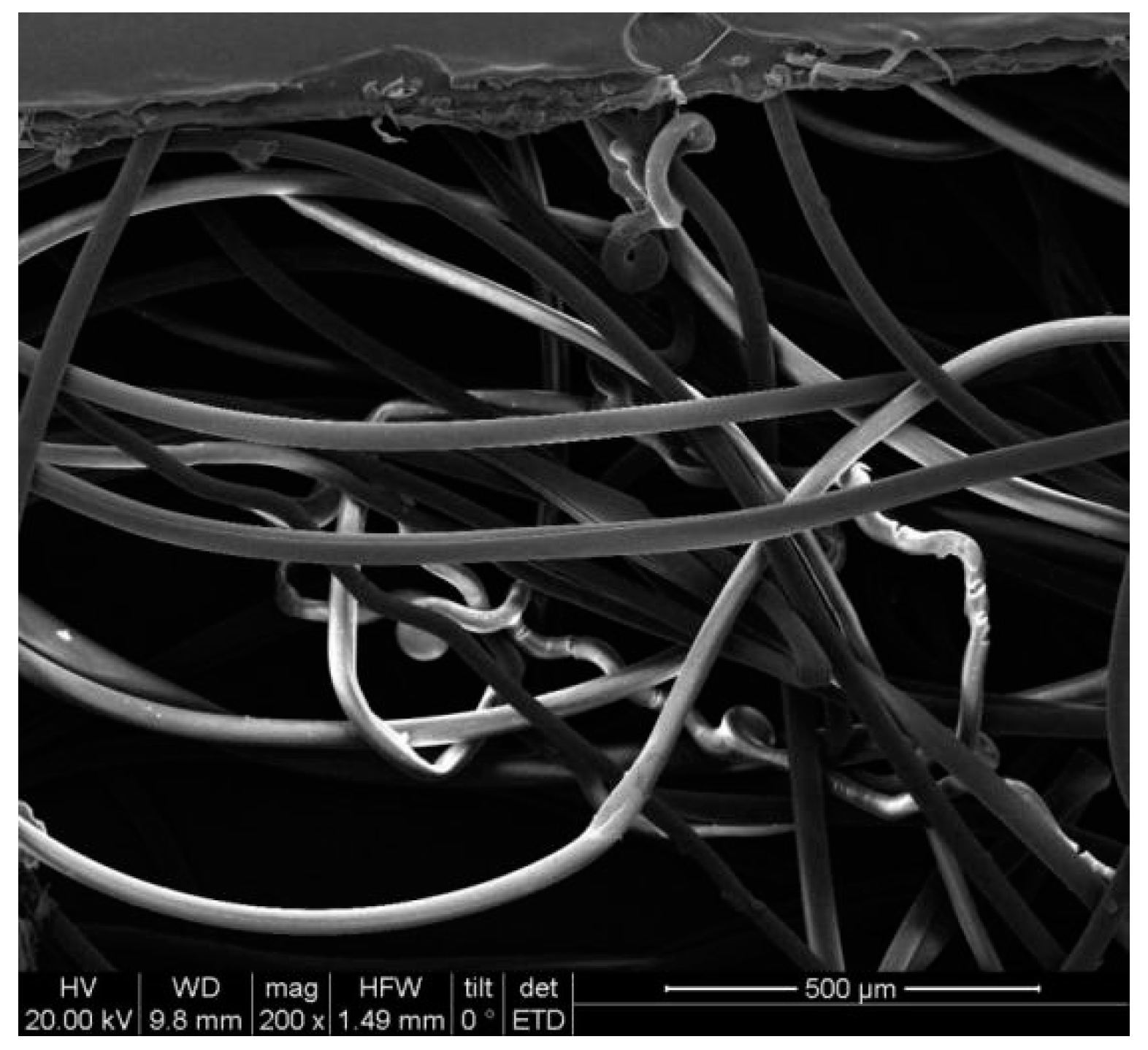
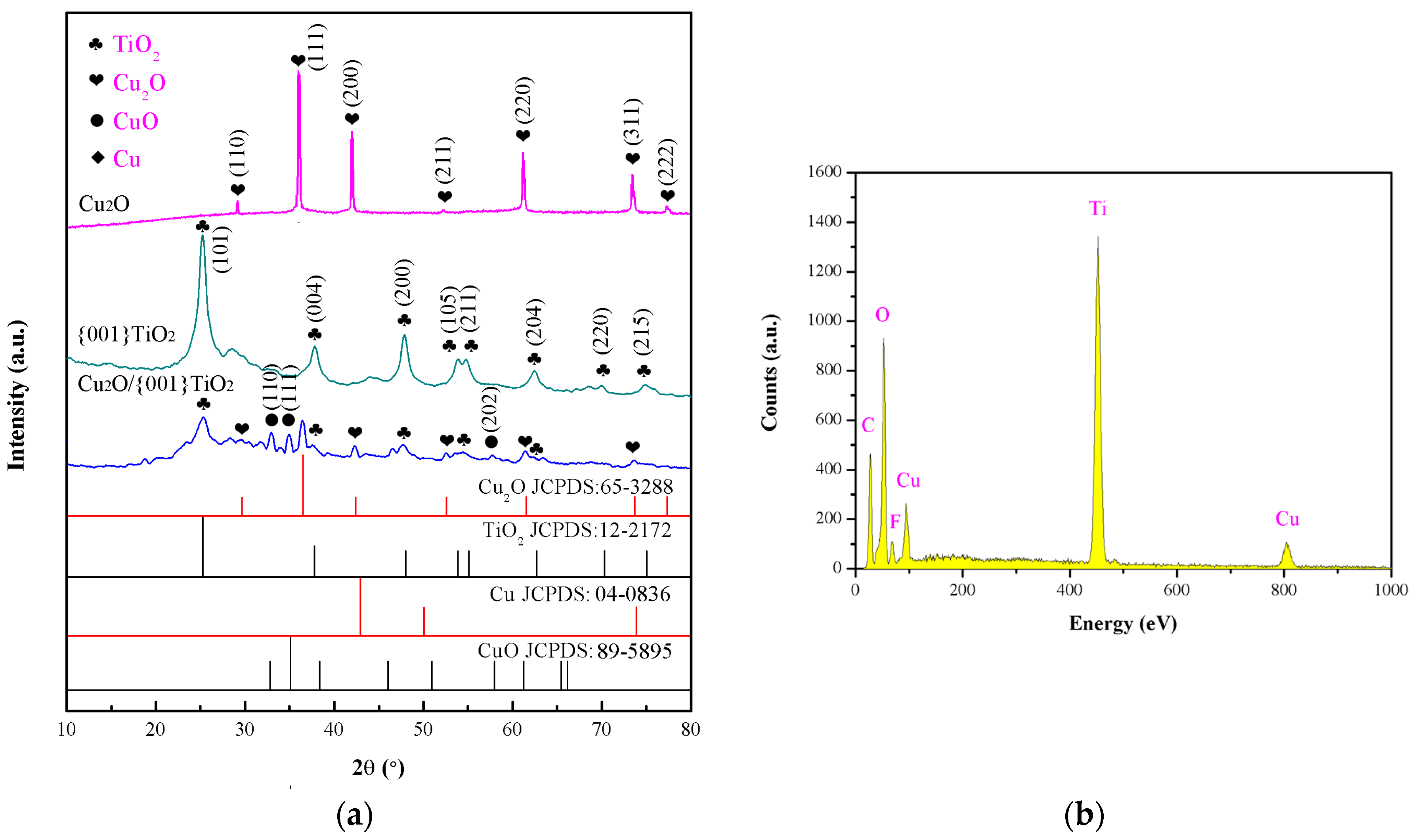
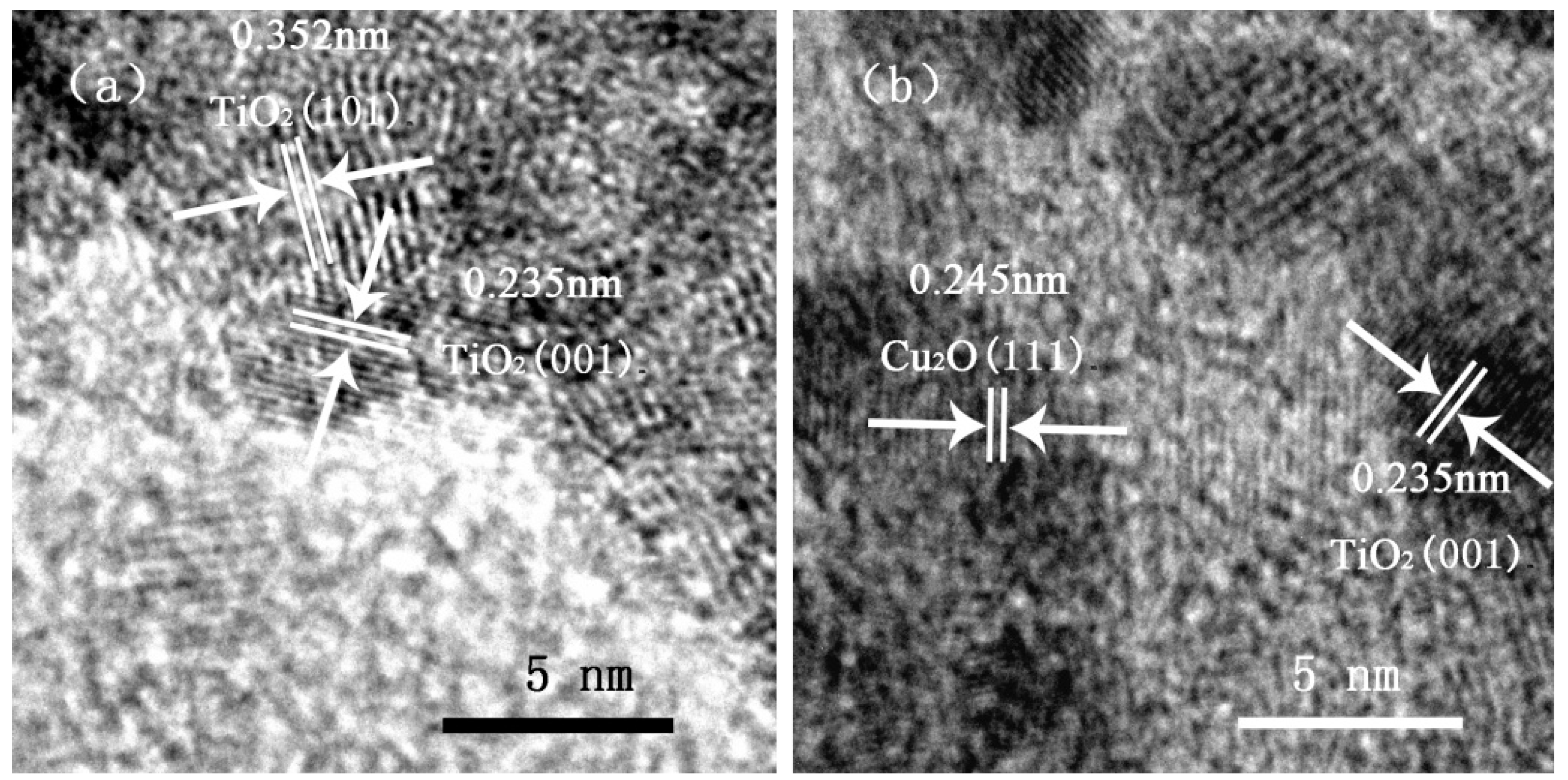
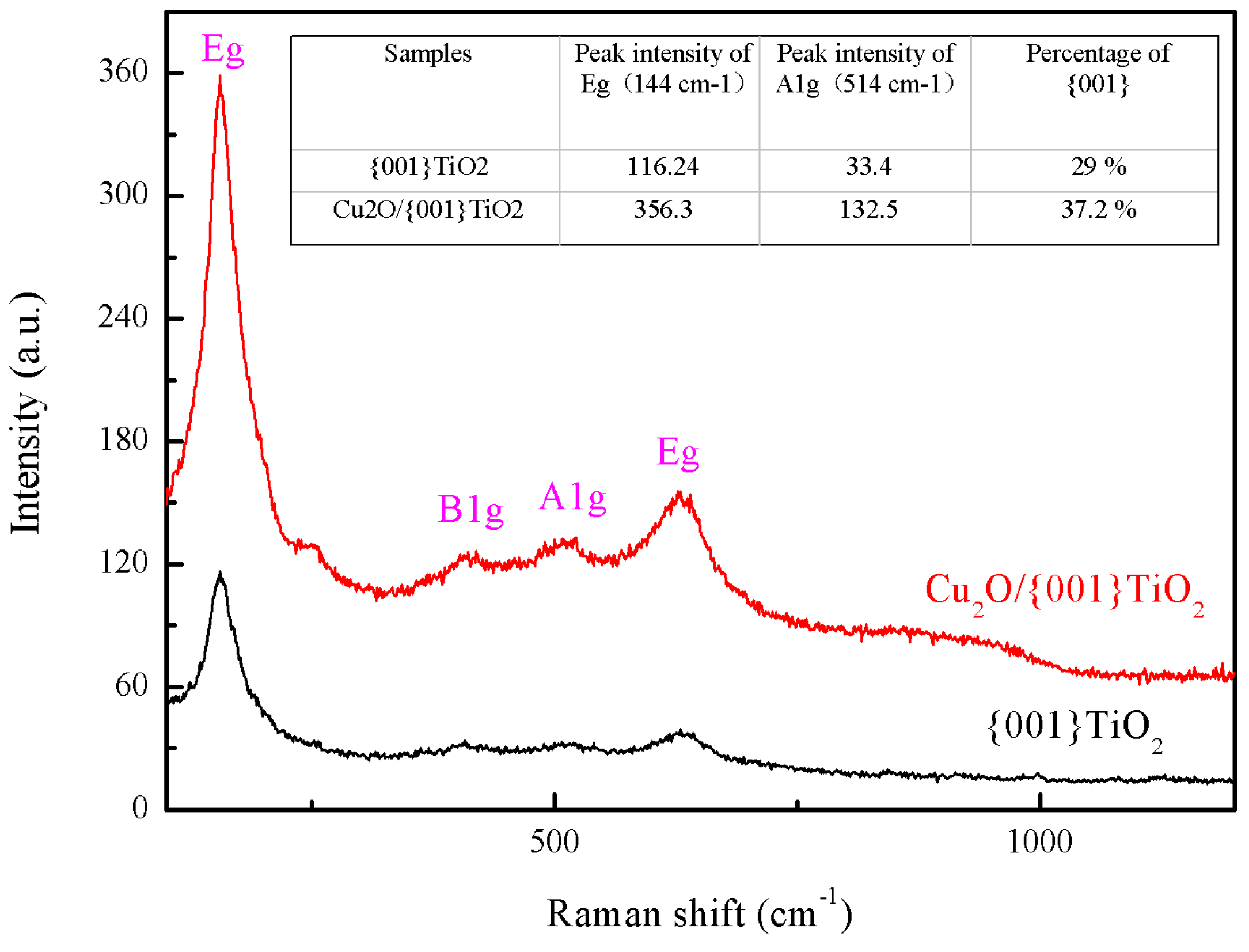
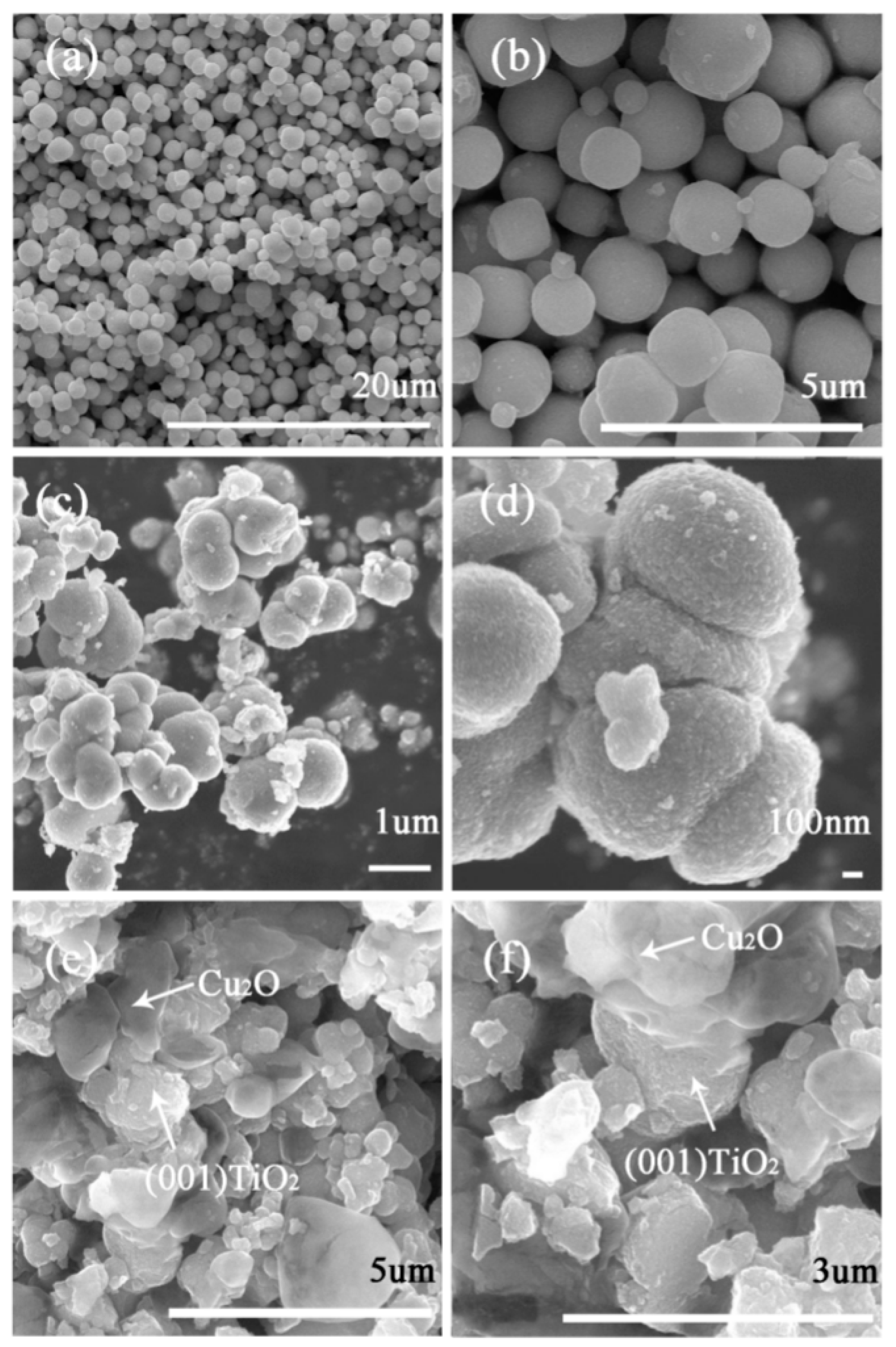
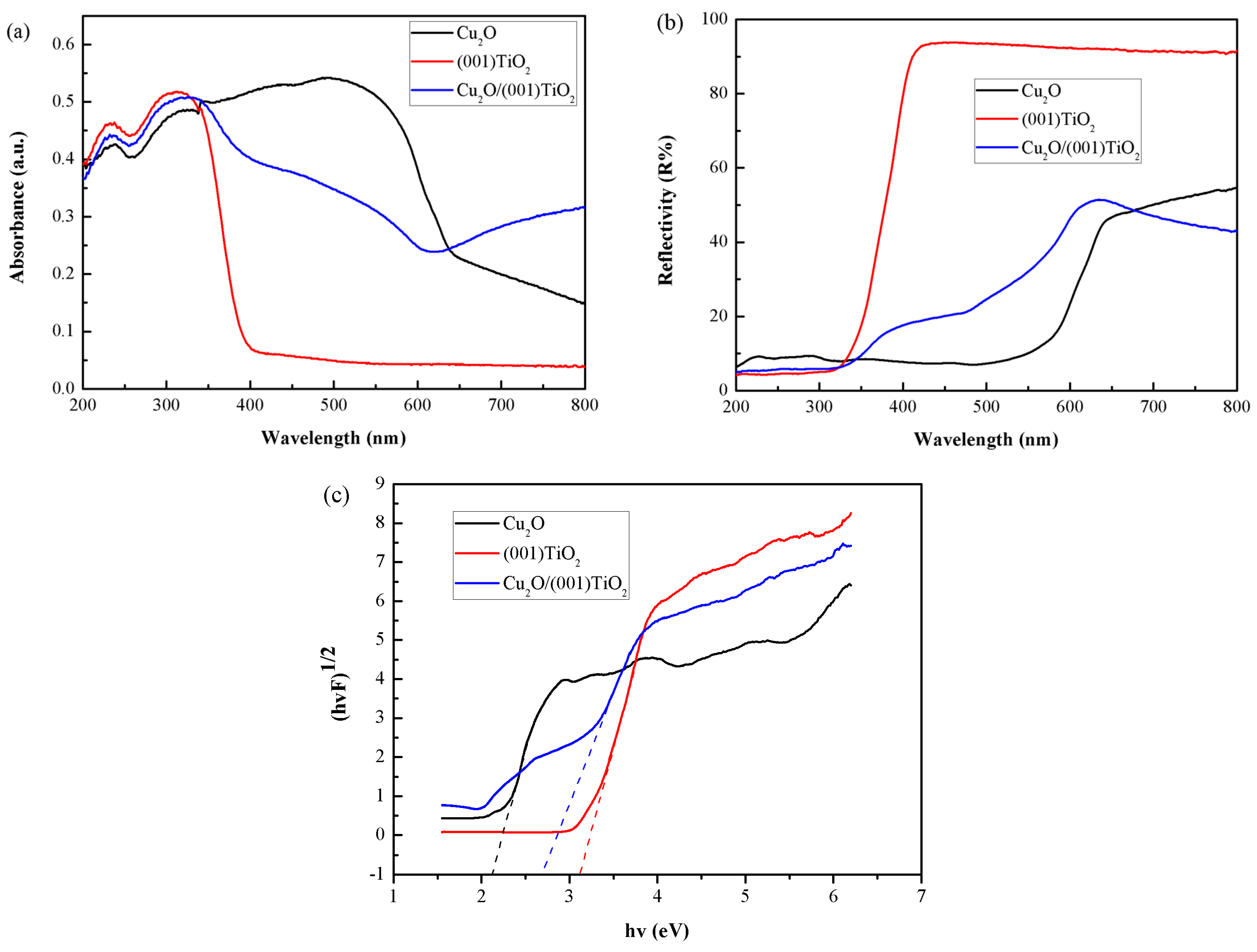
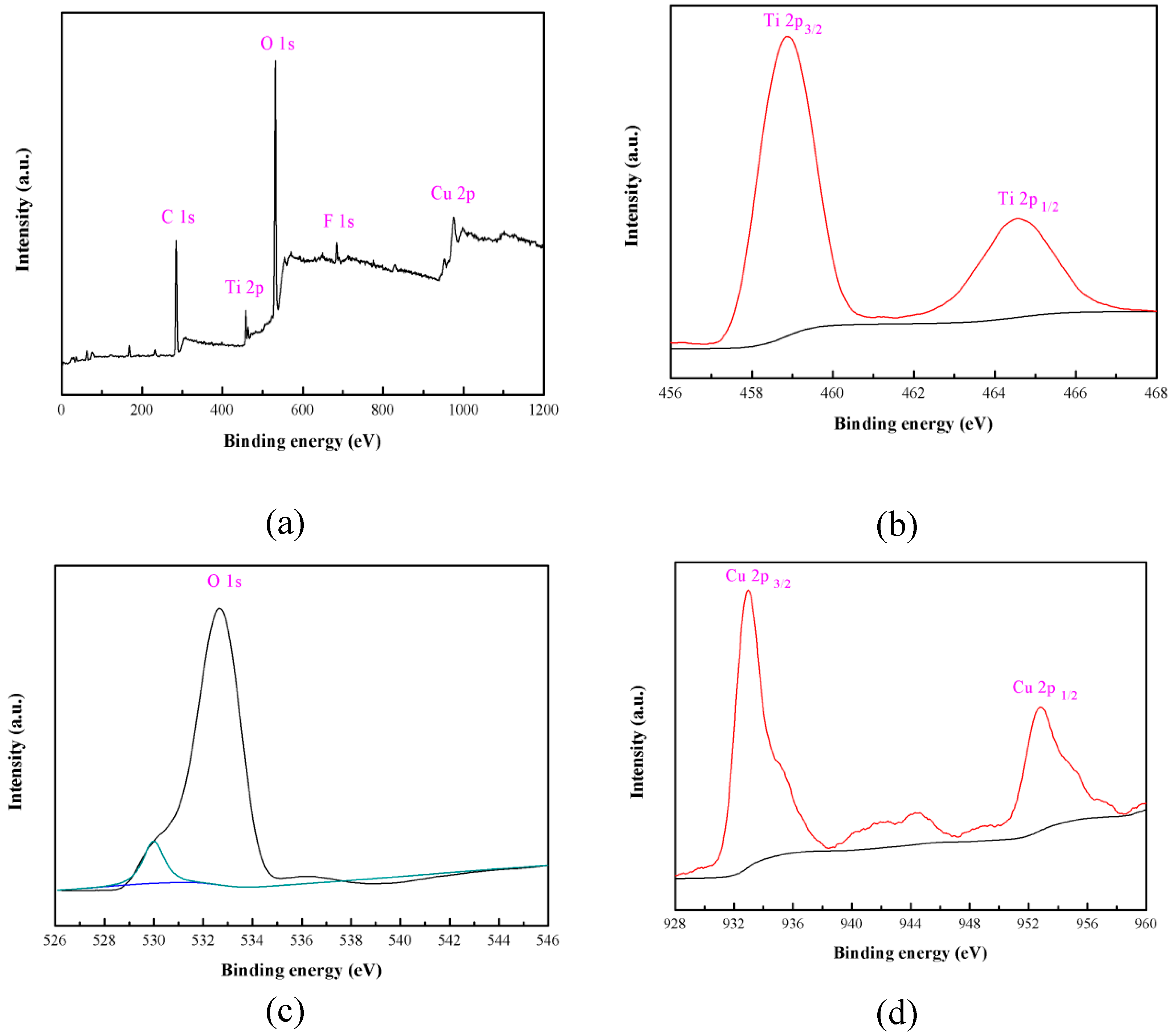

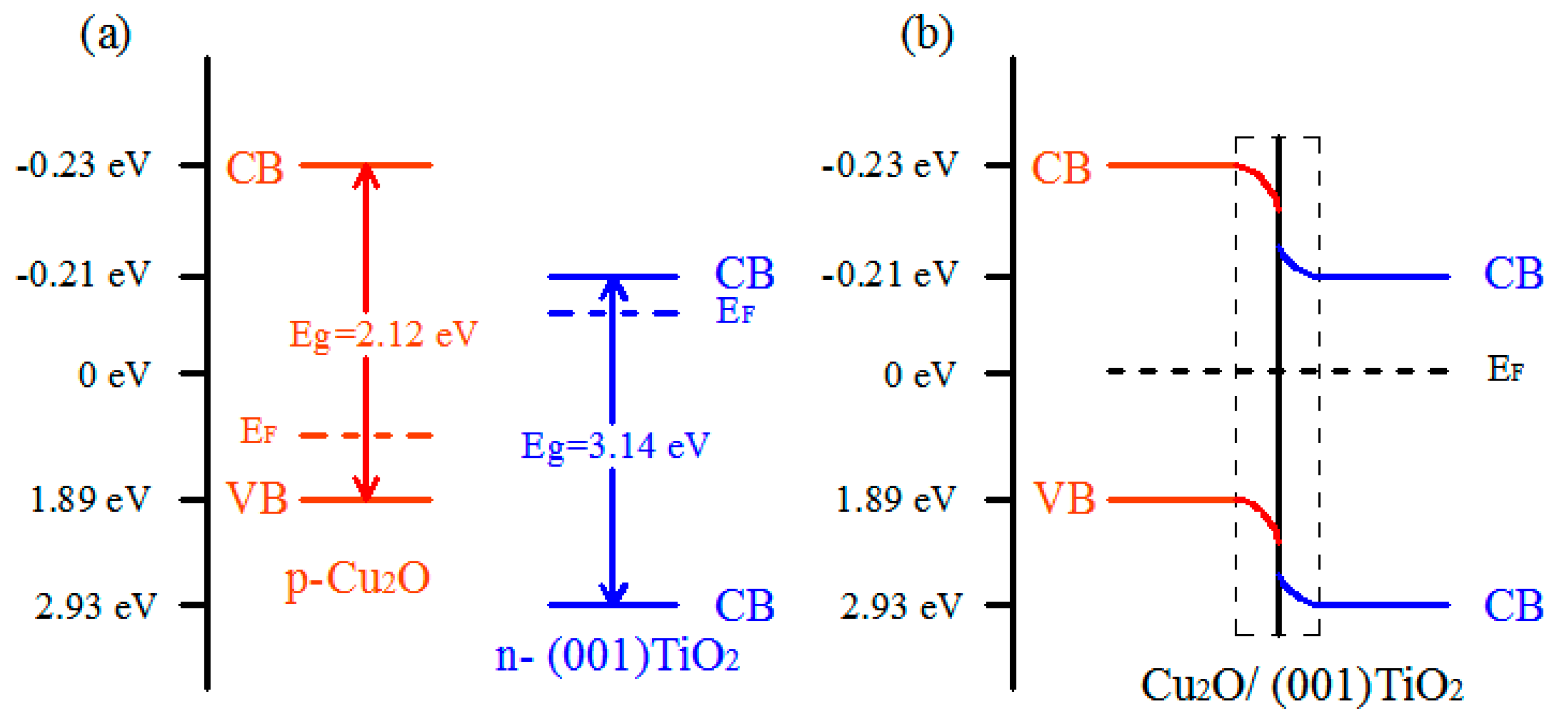
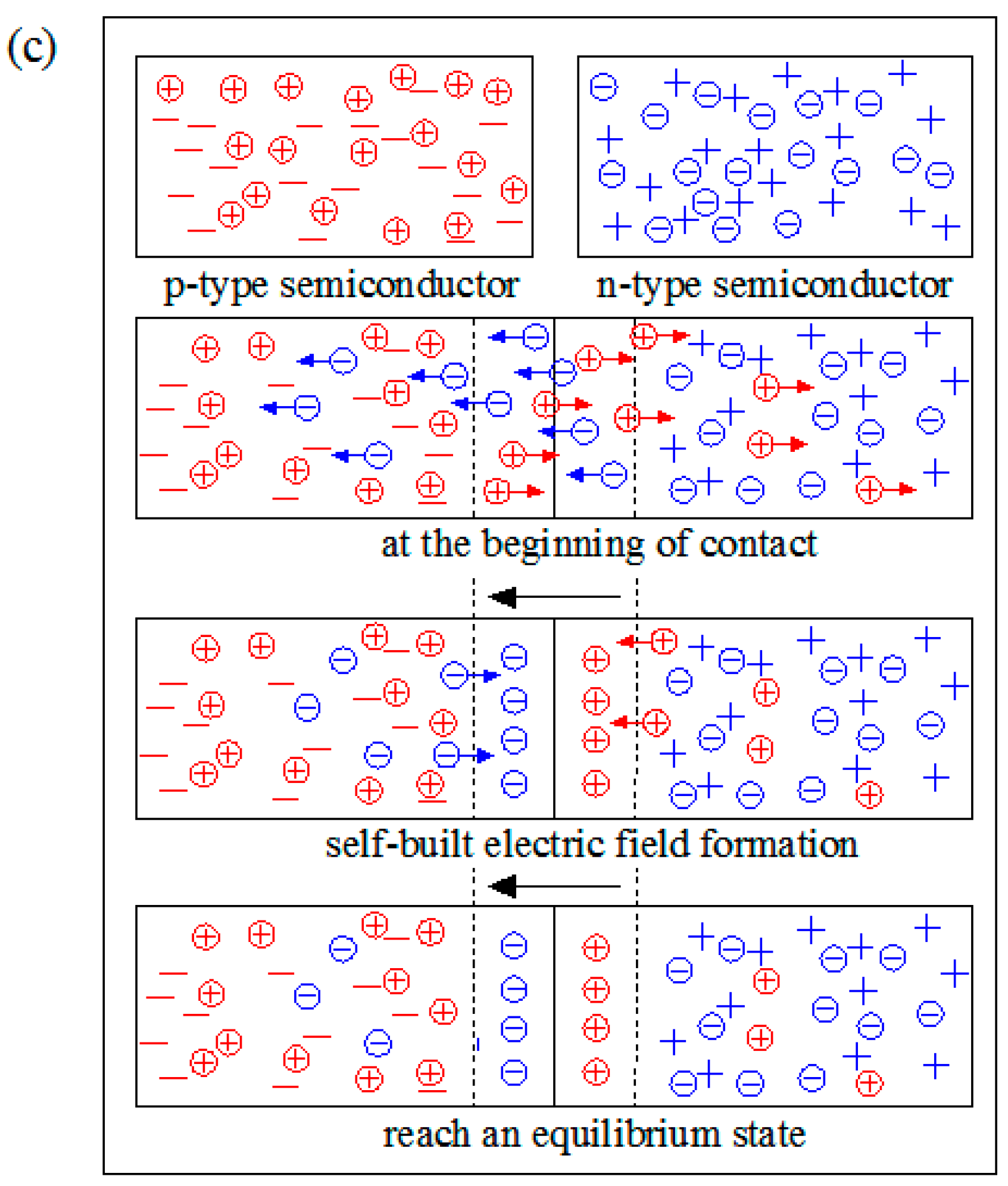
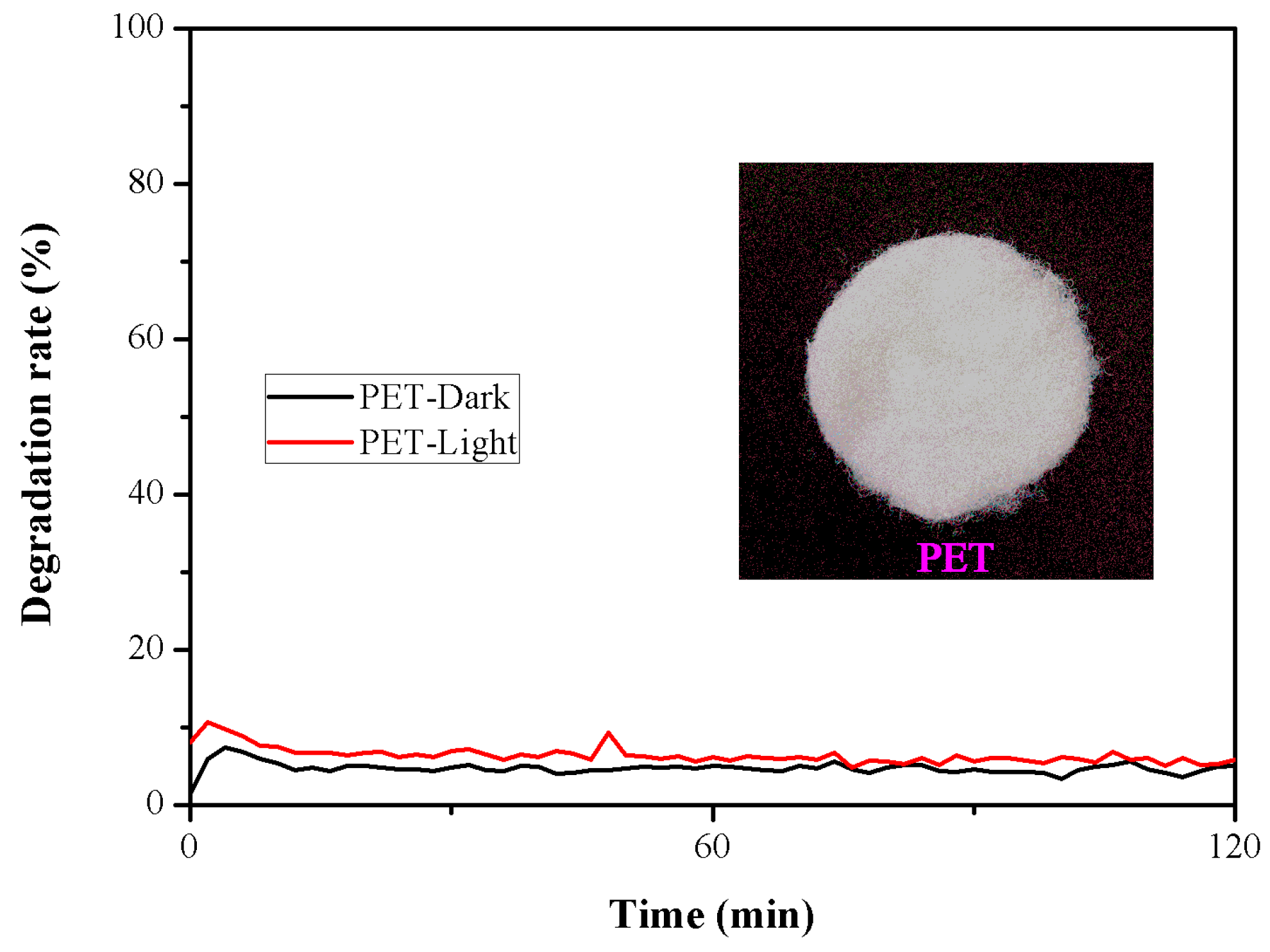
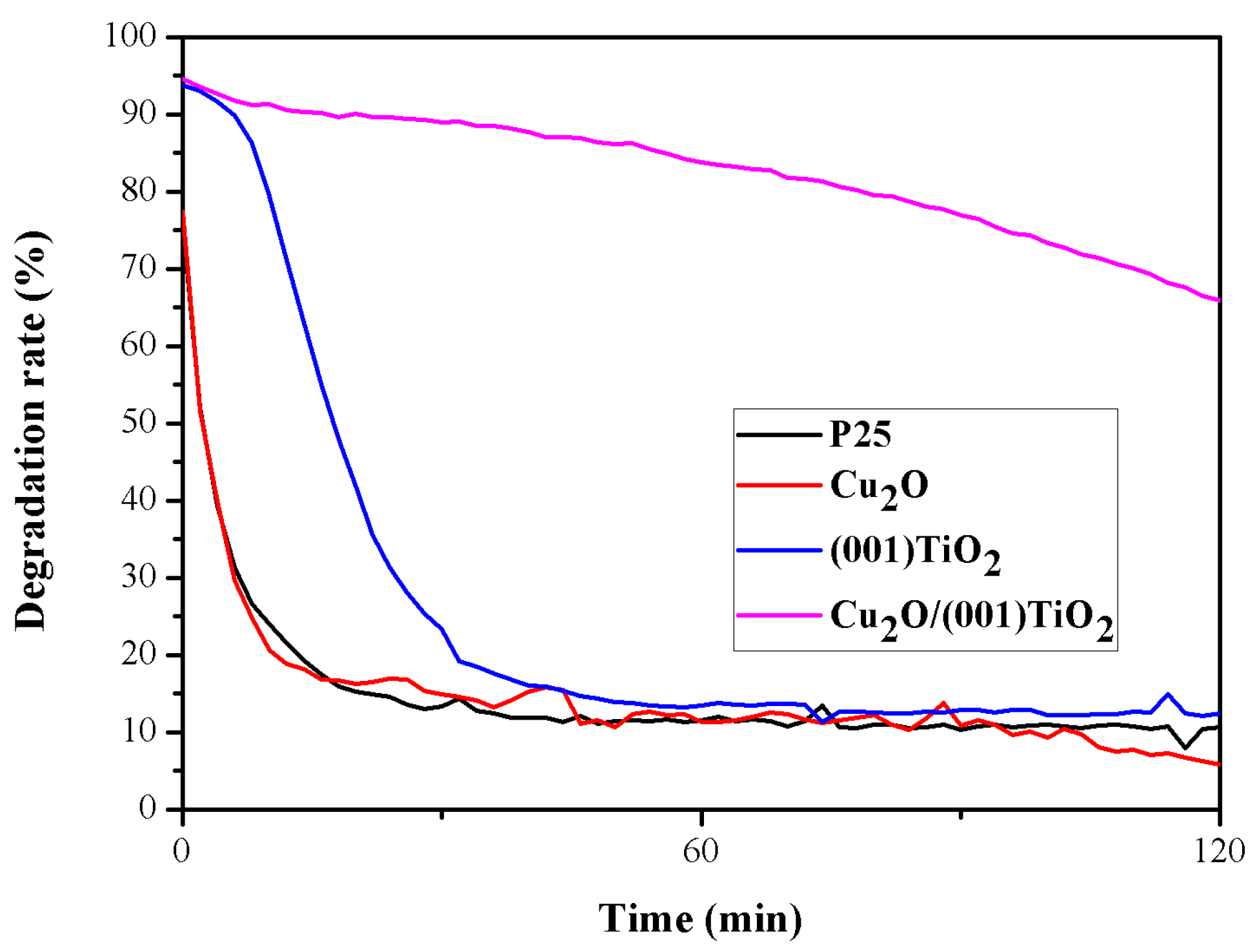
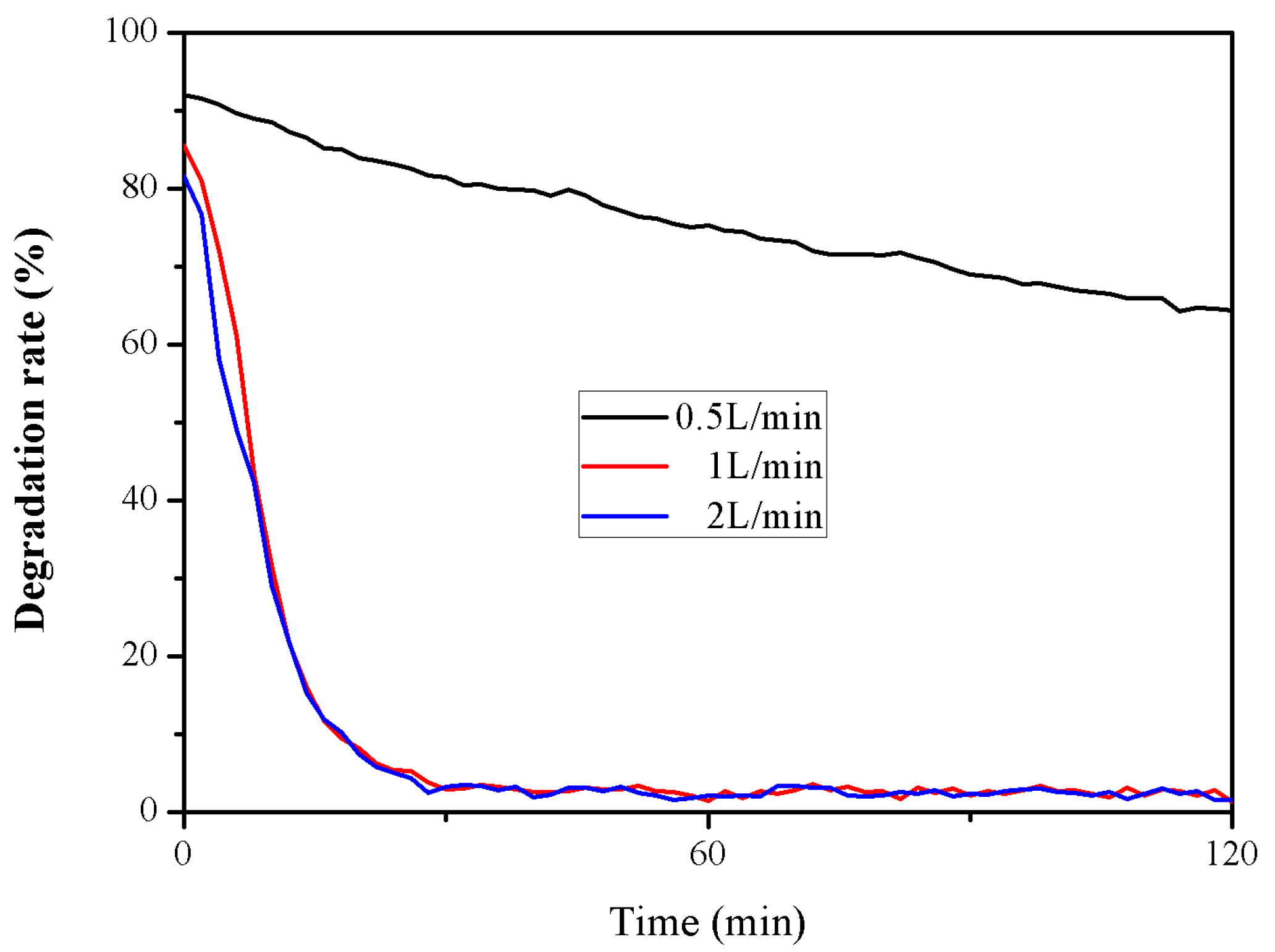

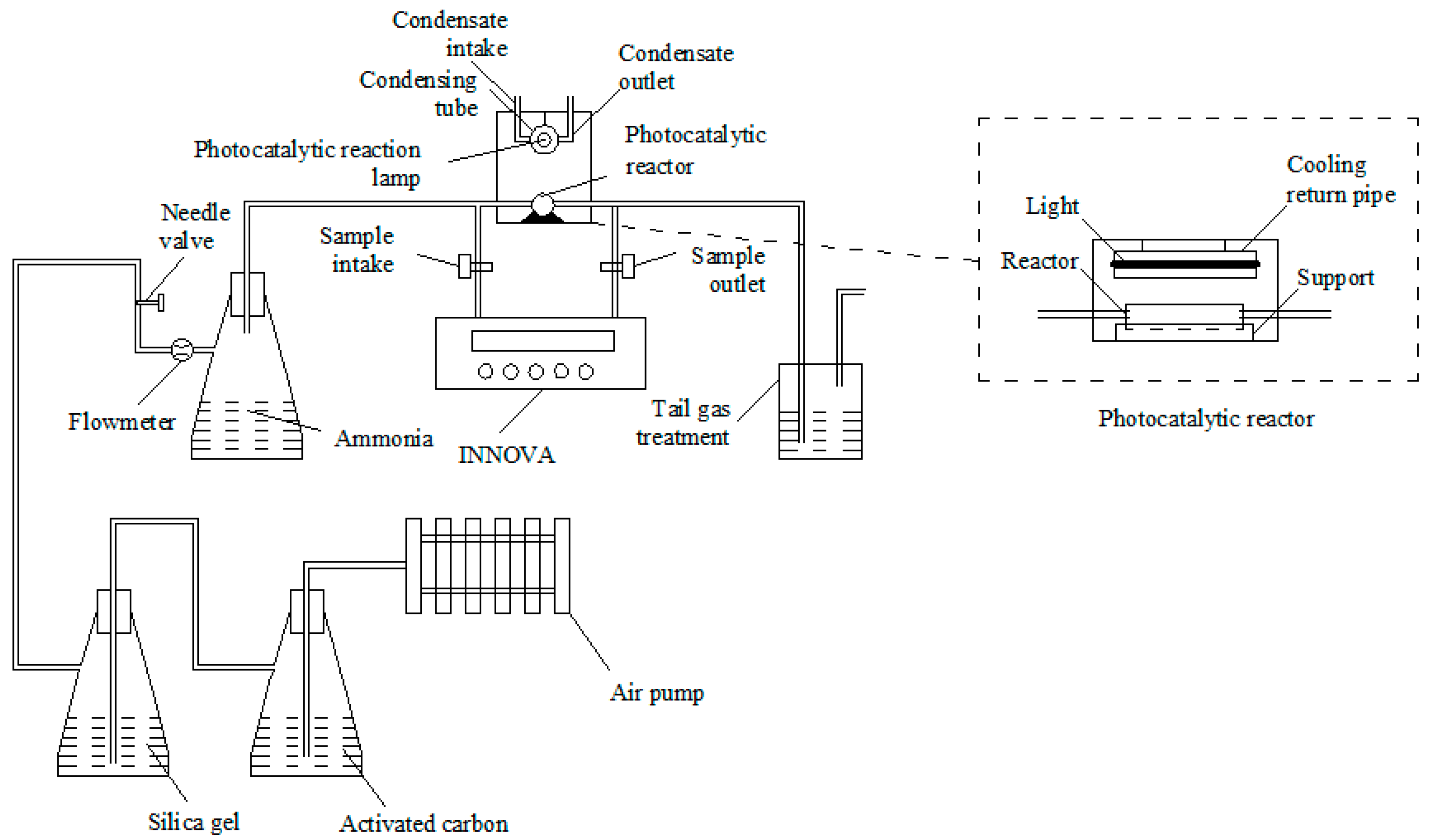
| Samples | Eg (eV) |
|---|---|
| Cu2O | 2.12 |
| (001)TiO2 | 2.68 |
| Cu2O/(001)TiO2 | 3.14 |
© 2019 by the authors. Licensee MDPI, Basel, Switzerland. This article is an open access article distributed under the terms and conditions of the Creative Commons Attribution (CC BY) license (http://creativecommons.org/licenses/by/4.0/).
Share and Cite
Pu, S.; Wang, H.; Zhu, J.; Li, L.; Long, D.; Jian, Y.; Zeng, Y. Heterostructure Cu2O/(001)TiO2 Effected on Photocatalytic Degradation of Ammonia of Livestock Houses. Catalysts 2019, 9, 267. https://doi.org/10.3390/catal9030267
Pu S, Wang H, Zhu J, Li L, Long D, Jian Y, Zeng Y. Heterostructure Cu2O/(001)TiO2 Effected on Photocatalytic Degradation of Ammonia of Livestock Houses. Catalysts. 2019; 9(3):267. https://doi.org/10.3390/catal9030267
Chicago/Turabian StylePu, Shihua, Hao Wang, Jiaming Zhu, Lihua Li, Dingbiao Long, Yue Jian, and Yaqiong Zeng. 2019. "Heterostructure Cu2O/(001)TiO2 Effected on Photocatalytic Degradation of Ammonia of Livestock Houses" Catalysts 9, no. 3: 267. https://doi.org/10.3390/catal9030267
APA StylePu, S., Wang, H., Zhu, J., Li, L., Long, D., Jian, Y., & Zeng, Y. (2019). Heterostructure Cu2O/(001)TiO2 Effected on Photocatalytic Degradation of Ammonia of Livestock Houses. Catalysts, 9(3), 267. https://doi.org/10.3390/catal9030267





